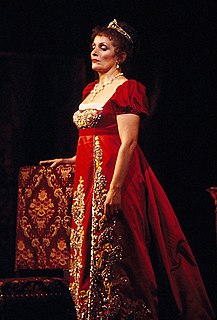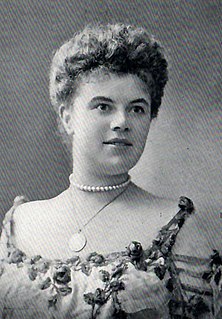Related Research Articles

Evelyn Shulman Lear was an American operatic soprano. Between 1959 and 1992, she appeared in more than forty operatic roles, appeared with every major opera company in the United States and won a Grammy Award in 1966. She was well known for her musical versatility, having sung all three main female roles in Der Rosenkavalier. Lear was also known for her work on 20th century pieces by Robert Ward, Alban Berg, Marvin David Levy, Rudolf Kelterborn and Giselher Klebe. She was married to the American bass-baritone Thomas Stewart until his death in 2006.

Edda Moser is a German operatic soprano. She was particularly well known for her interpretations of music by Mozart. Her 1973 recital LP Virtuose Arien von W.A. Mozart received the Grand Prix du Disque.

Cheryl Studer is an American dramatic soprano who has sung at many of the world's foremost opera houses. Studer has performed more than eighty roles ranging from the dramatic repertoire to roles more commonly associated with lyric sopranos and coloratura sopranos, and, in her late stage, mezzo-sopranos. She is particularly known for her interpretations of the works of Richard Strauss and Richard Wagner.
Júlia Várady is a Hungarian-born German soprano who started out as a mezzo-soprano.

Hildegard Behrens was a German operatic soprano with a wide repertoire including Wagner, Weber, Mozart, Richard Strauss, and Alban Berg roles. She performed at major opera houses around the world, and received several Grammy Awards for performances with the Metropolitan Opera.
Helga Dernesch is an Austrian soprano and mezzo-soprano. Her career has taken her through four successive phases: from mezzo-soprano to lyric soprano to dramatic soprano, and after about 1980 back to mezzo again. "Her voice had great richness and power, and her strikingly handsome stage appearance and intense acting made her a compelling performer."

Violeta Urmana is a Lithuanian opera singer who has sung leading mezzo-soprano and soprano roles in the opera houses of Europe and North America.
Dunja Vejzović is an operatic mezzo-soprano and soprano from Croatia.
Hanna Schwarz is a German mezzo-soprano and contralto singer in opera and concert. In 1976 she performed the roles of Fricka and Erda in the centenary Jahrhundertring production at the Bayreuth Festival, directed by Patrice Chéreau.

Marta Fuchs was a German concert and operatic soprano.
Mojca Erdmann is a German soprano who is particularly associated with the Mozart operas. She created the role of Ariadne in Rihm's Dionysos at the Salzburg Festival.
Turid Karlsen is a Norwegian operatic soprano and voice teacher who has had an active international performing career since the 1980s. Known for her portrayals of roles from the dramatic soprano repertoire, she won the Kirsten Flagstad Prize in 2004 for her portrayal of Senta in Richard Wagner's Der Fliegende Holländer with the Norwegian National Opera. During her career, she has performed under the batons of several notable conductors, including Daniel Barenboim, Dennis Russell Davies, Placido Domingo, Hartmut Haenchen, Kent Nagano, and Michael Tilson Thomas. She is currently a professor of vocal music at the Hochschule für Musik und Theater Hamburg.
Lioba Braun is a German opera singer and academic teacher at the Hochschule für Musik und Tanz Köln and the Hochschule für Musik und Theater München. Based at the Nationaltheater Mannheim, she has appeared mostly in mezzo-soprano parts at major opera houses and festivals. She became internationally known appearing as Brangäne at the Bayreuth Festival in 1994, and performed the soprano part of Isolde on stage first in 2012.
Hedwig Fassbender is a German operatic mezzo-soprano and academic voice teacher. She has appeared in leading roles at major European opera houses, including some soprano roles such as Wagner's Isolde and Sieglinde.

Virginia Gungl was a German soprano of Hungarian origin, prima donna on the stages in Munich and Frankfurt. Her voice spanned more than two octaves.
Spas Wenkoff was a Bulgarian-Austrian operatic tenor. He was known internationally for mastering the heldentenor roles by Wagner, such as Tristan and Tannhäuser. He appeared in his signature role Tristan first in 1975 at the Staatsoper Dresden, followed by the centenary Bayreuth Festival in 1976, and the Metropolitan Opera in 1981, among many others. He was a member of the Staatsoper Berlin from 1976 to 1984, and then appeared freelance at major opera houses. He was awarded the title Kammersänger in both Berlin and Vienna.

Helena Forti was a dramatic soprano active 1906 – 1924, closely associated with the Dresden royal court opera, known for her beauty, voice and strong stage presence. She sang all Wagner’s opera heroines, in Dresden, Bayreuth and internationally. Other repertoire included the title role in Verdi’s Aida, Santuzza in Cavalleria and contemporary works like Marietta in Korngold’s Die tote Stadt. She created the role of Mytocle in Eugen d’Albert’s opera Die toten Augen. Her Sieglinde in Die Walküre in Braunschweig was described by the Neue Zeitschrift für Musik as “Equally endowed with youth, beauty and vocal means... (Forti) immerses herself so intensely in her role that one believes the transformation of the virgin-Goddess into a human form.” After retiring from singing she taught voice and acting in Gera, Düsseldorf and Vienna. She died in Vienna, where she lived with her stage director and Intendant husband, Walter Bruno Iltz.
Charlotte Huhn was a German operatic contralto.
Linda Watson is an American dramatic soprano and academic voice teacher. She made her career based in Germany where she studied and began as a mezzo-soprano at the Theater Aachen. She has performed worldwide, including at the Vienna State Opera, La Scala, the Metropolitan Opera and the Bayreuth Festival. She focused on dramatic roles by Wagner, including Brünnhilde and Isolde, and Strauss, including Ariadne and the Dyer's Wife. She was awarded the title Kammersängerin in Germany in 2004 and in Austria in 2020.

Helena Braun was a German dramatic soprano. She made her stage debut in Mozart's Le nozze di Figaro in 1928 and joined the Vienna State Opera and the Bavarian State Opera in 1939 and 1940, respectively. She became known for Wagnerian roles such as Brünnhilde in Der Ring des Nibelungen and Ortrud in Lohengrin.
References
- ↑ Ligendza, Caterina (Soprano) on the Metropolitan Opera Database. Accessed 31 March 2009.
- ↑ "Performance Database".
Much of the information in this article is taken from «Catarina Ligendza» in the German Wikipedia. The source texts listed below are from the original article:
- Lexikon der Interpreten klassischer Musik im 20. Jahrhundert, Bärenreiter-Verlag, Kassel 1992, ISBN 3-7618-3291-5
- Jens Malte Fischer, Große Stimmen Suhrkamp Verlag 1995
Further reading